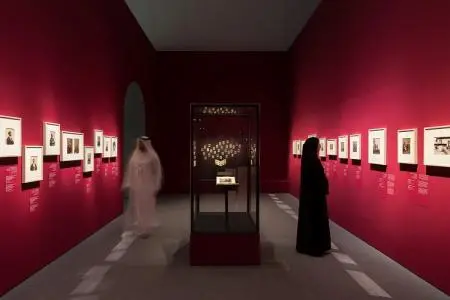PHOTO
A selection of the world’s earliest photographs at Louvre Abu Dhabi
Abu Dhabi: Louvre Abu Dhabi’s fourth international exhibition of the cultural season A World of Exchanges, Photographs 1842 – 1896: An Early Album of the World, explores the development of photography in its first years of existence, in a rare display of some of the earliest images taken by travellers and sailors in the Middle East, Africa, Asia, India and the Americas. Running until 13 July 2019, the exhibition traces the dissemination of photography as a form of presentation and documentation, and an instrument of discovering and understanding the world and its people, through a wide selection of over 250 historic photographs taken between 1842 and 1896.
Organised by Louvre Abu Dhabi, musée du quai Branly – Jacques Chirac and Agence France-Muséums, and sponsored by the Bank of Sharjah, the exhibition includes some of the earliest photographs produced outside of Europe. The works on display include exceptional loans from musée du quai Branly – Jacques Chirac, Bibliothèque nationale de France, musée national des arts asiatiques – Guimet, l’Etablissement public du Musée d’Orsay, la Société de Géographie and La Cité de la Céramique – Sèvres & Limoges. The exhibition is curated by Christine Barthe, Head of the Photographic Collections Heritage Unit at the musée du quai Branly – Jacques Chirac.
HE Mohamed Khalifa Al Mubarak, Chairman of the Department of Culture and Tourism – Abu Dhabi, said: “Louvre Abu Dhabi aims to tell the story of humanity, and photography is one of the most important tools that has contributed to the documentation of the history of the world and its diverse cultures. Photographs 1842 – 1896: An Early Album of the World is yet another testament to how Louvre Abu Dhabi brings the world to our city. The museum’s first-ever photography exhibition complements Abu Dhabi’s colourful cultural landscape by giving visitors the opportunity to travel to new places and explore different regions of the world through the eyes of 19th century travellers.”
Grand Cañon. Colorado River, near Paria Creek. Looking West. Arizona, United States. 1872. William Bell (1830 – 1910). Albumen print. Paris, musée du quai Branly – Jacques Chirac. Photo credit: © musée du quai Branly – Jacques Chirac, Dist. RMN – Grand Palais / image musée du quai Branly – Jacques Chirac
The exhibition displays works by prominent international photographers, including Charles Guillain, a French ship’s captain who took part in a diplomatic voyage down the coast of Africa in 1847-48; Désiré Charnay, an archaeologist who photographed the first pre-Hispanic sites in Mexico; Marc Ferrez, the first Brazilian photographer to receive international recognition; William Ellis, an English missionary who travelled through Madagascar; Lai Afong a Chinese photographer who established one of the early photographic studios in Hong Kong; Kassian Cephas, the first Indonesian to become a professional photographer, and Egyptian military engineer Muhammad Sadiq Bey, who took the first photographs of the Holy Places in Medina and Mecca circa 1881. The exhibition also presents a visual record of Auguste Bartholdi’s voyage to Egypt, Nubia (current day Sudan) and Palestine to photograph the principal monuments. This collection was his first and last interaction with the medium of photography, before he went on to sculpt the Statue of Liberty.
Emir Abd el-Kader (aged 57), born in Maskara (Province of Oran, Algeria), Paris, 1865
Jacques Philippe Potteau (1807 – 1876)
Albumen print. Paris, musée du quai Branly – Jacques Chirac. Photo credit: © musée du quai Branly – Jacques Chirac, Dist. RMN – Grand Palais / image musée du quai Branly – Jacques Chirac
Reflecting on the universal character of the museum, Manuel Rabaté, Director of Louvre Abu Dhabi, stated: “It’s with immense pride that Louvre Abu Dhabi hosts its first photography exhibition as part of our cultural season ‘A World of Exchanges’. Photographs 1842 – 1896: An Early Album of the World explores the evolution of photography as a universal medium and brings together under our dome, the collective stories of these photographers from all over the world. We are in debt to musée du quai Branly – Jacques Chirac, particularly its President Stéphane Martin and the exhibition’s curator Christine Barthe as well as Agence France-Muséums for being instrumental in the organisation of this exhibition and of course our sponsor Bank of Sharjah for their patronage.”
Dr. Souraya Noujaim, Scientific, Curatorial & Collections Management Director at Louvre Abu Dhabi added: “Photographs 1842 – 1896: An Early Album of the World is the museum’s first exhibition dedicated solely to the medium of photography. Visitors will be able to discover some of the world’s earliest photographic images from across the world and get to know the stories behind the first photographers from Europe, Asia, Africa and the Americas. This pioneer exhibition shows the dissemination and appropriation of this medium around the world – a technical revolution that changed, for good, the status of the image and the way it was used.”
In an attempt to showcase the passing of using the medium of photography by European explorers to local authorities and rulers, the show presents the earliest photographic images from India by Lala Deen Dayal, an engineer by training who developed a passion for photography and opened several professional studios in different Indian cities. During the Ottoman empire in Constantinople, otherwise known as modern day Istanbul, the Abdullah Brothers rose to fame by photographing the Ottoman elite and the new ruling classes.
Muhammad Sadiq Bey (1822 – 1902). View of the Holy Shrine and the City of Mecca, Saudi Arabia, 1881. Photographic print. Paris, Bibliothèque nationale de France, Rare Books Reserve. Photo credit: © Bibliothèque nationale de France, Paris
The show will also highlight historic photographs from the Philippines, including works by Pedro Picon, the creator of one of the earliest photographs in the country. An album from musée du quai Branly –Jacques Chirac, which is presented in the exhibition, contains an early selection of studio portraits in carte-de-visite format.
Stéphane Martin, President of the musée du quai Branly – Jacques Chirac, said: “The exhibition Photographs 1842 – 1896: An early album of the world marks an important stage in the partnership between the musée du quai Branly – Jacques Chirac and the Louvre Abu Dhabi. Through works of rare quality taken from the collections of the musée du quai Branly – Jacques Chirac and exceptional loans, the exhibition retraces the spread of photography through its technical, social and cultural aspects. From Japan to Brazil, Gabon to Java and Tasmania to Yemen, the geographic area and the scope of practices covered are unprecedented. A fascinating story of perspectives and images, of photography itself.”
Christine Barthe, Head of the Photographic Collections Heritage Unit at the musée du quai Branly – Jacques Chirac and curator of the exhibition, said: The exhibition Photographs 1842 – 1896: An Early Album of the World was born from a desire to present, in Abu Dhabi, some of the earliest photographic images recorded on earth. To meet this challenge, we had to shift focus and lead extensive research to look towards the new horizons of the birth of photography outside Europe and the United States. This exhibition offers, for the first time, a global history of the first steps of photography, whose development in South America, Africa, the Middle East and Asia reveals a fascinating play of difference and similarity. The exhibition will immerse visitors into a set of images of great beauty, fascinating stories and discoveries. I believe it will be full of surprises for visitors, who will not only discover the first evidences of the visual mapping of the world, but also question our fascination and our current dependence on photographic images.”
The Maharani of Nepal and her Ladies in Waiting. Nepal. 1885 – 1894. Johnston & Hoffmann. (Active 1880 – 1950). Albumen print. Paris, musée du quai Branly – Jacques Chirac. Photo credit: © musée du quai Branly – Jacques Chirac, Dist. RMN – Grand Palais / image musée du quai Branly – Jacques Chirac
Alongside the exhibition, Louvre Abu Dhabi will host a range of educational and cultural activities around the theme of photography, including workshops, four film screenings, a conference and a cine-concert entitled In the Land of the Head Hunters, after the name of the movie directed by American photographer and ethnologist Edward S. Curtis on 25 and 26 of April. In this unique live concert, French musician Rodolphe Burger performs his musical interpretation of one of the most beautiful silent-movies ever made. Mixing electronic and Native American music, Burger improvises the score for this rare 1914 movie masterpiece, a Native American version of Romeo and Juliet, where love leads to war and murder.
Entrance to the exhibition is free with the museum’s admission ticket. Admission is free for children under the age of 13.
Visitors can tour the exhibition through a multimedia guide that is available in Arabic, English, and French. A catalogue highlighting key historical moments illustrating the circumstances in which photography was introduced and practiced around the world is available.
Dead crocodile on a boat on the Nile, Egypt, 1852
Ernest Benecke (1817 – 1894).Salt paper print. Paris, Bibliothèque nationale de France, Manuscripts Department. Émile Prisse d’Avennes Egyptian Collection. Photo credit: © Bibliothèque nationale de France, Paris
For more information on the exhibition or ticket bookings, please visit www.louvreabudhabi.ae or call Louvre Abu Dhabi at +971 600 56 55 66.
-Ends-
SOCIAL MEDIA ACCOUNTS
Follow Louvre Abu Dhabi on social media: Facebook (Louvre Abu Dhabi), Twitter (@LouvreAbuDhabi) and Instagram (@LouvreAbuDhabi) #LouvreAbuDhabi
VISITOR INFORMATION
Louvre Abu Dhabi hours are: Saturday, Sunday, Tuesday, and Wednesday, 10 am–8 pm; Thursday and Friday, 10 am–10 pm. The museum is closed on Mondays.
Last entries and ticket purchases end 30 minutes prior to closing. Special visitor hours will be in effect during some holidays and Ramadan.
General admission tickets are 63 AED (including VAT). Reduced access tickets are 31.5 AED (including VAT) for visitors aged 13-22, UAE education professionals, and members of the military.
Admission is free for members of the museum’s loyalty programme, children under the age of 13, ICOM or ICOMOS members, journalists and visitors with special needs and their companions.
ABOUT LOUVRE ABU DHABI
Created by an exceptional agreement between the governments of Abu Dhabi and France, Louvre Abu Dhabi was designed by Jean Nouvel and opened on Saadiyat Island in November 2017. The museum is inspired by traditional Islamic architecture and its monumental dome creates a rain of light effect and a unique social space that brings people together.
Louvre Abu Dhabi celebrates the universal creativity of mankind and invites audiences to see humanity in a new light. Through its innovative curatorial approach, the museum focuses on building understanding across cultures: through stories of human creativity that transcend civilisations, geographies and times.
The museum’s growing collection is unparalleled in the region and spans thousands of years of human history, including prehistoric tools, artefacts, religious texts, iconic paintings and contemporary artworks. The permanent collection is supplemented by rotating loans from 13 French partner institutions, regional and international museums.
Louvre Abu Dhabi is a testing ground for new ideas in a globalised world and champions new generations of cultural leaders. Its international exhibitions, programming and Children’s Museum are inclusive platforms that connect communities and offer enjoyment for all.
In 2019—the declared Year of Tolerance in the United Arab Emirates—Louvre Abu Dhabi will continue to be a hub for all cultures and a symbol of openness, hope, tolerance and inclusivity in the Arab world.
ABOUT MUSÉE DU QUAI BRANLY – JACQUES CHIRAC
The musée du quai Branly – Jacques Chirac opened in June 2006 and is dedicated to the arts and civilisations of Africa, Asia, Oceania and the Americas. Designed by architect Jean Nouvel, the building housing the museum, which stands just a stone’s throw from the Eiffel Tower, has become a symbol of Parisian heritage. The museum attracts nearly 1.3 million visitors from all continents every year.
With some 370,000 artefacts, 700,000 photographic pieces and over 200,000 works of reference under its guardianship, not to mention multiple masterpieces, the museum’s collection is one of the most extensive in the world. The pieces housed at the museum bear testimony to the genius of man and the lives of the societies from which they hail and are naturally of major cultural and scientific interest.
The museum also offers a rich and diverse programme of events and initiatives designed to offer a greater insight into non-European arts and societies, along with various permanent and temporary exhibitions, concerts, performances, readings and lectures that make the musée du quai Branly – Jacques Chirac a thriving cultural venue where cultures interact on a daily basis.
The musée du quai Branly – Jacques Chirac has lent about 30 masterpieces from its collections that are displayed in the Louvre Abu Dhabi’s permanent galleries, including a Teotihuacan Mask (Mexico), a rare ivory salt cellar from Benin and a D’mba mask (Guinea).
ABOUT BANK OF SHARJAH
Under the Honorary Chairmanship of H.H. Dr. Sheikh Sultan Bin Mohammed Al Qasimi, Member of the Supreme Council Ruler of Sharjah, a decree was issued calling for the creation of Bank of Sharjah on December 22, 1973, operations started in May 1974. The Bank was the first financial institution in Sharjah and the fifth in the Federation, the first to make 40% of its capital available for public subscription and the first Emirati Bank in the Republic of Lebanon.
ABOUT MUSÉE DU LOUVRE
The Louvre in Paris opened in 1793, during the French Revolution, and from the very beginning was intended to provide inspiration for contemporary art. Courbet, Picasso, Dalí and so many others came to its hallowed halls to admire the old masters, copy them, immerse themselves in masterpieces and improve and fuel their own art. As an ancient royal residence, the Louvre is inextricably linked to eight centuries of French history. As a universal museum, its collections, among the best in the world, span many millennia and miles, from the Americas to Asia. Over 38,000 artworks are grouped into eight curatorial departments, including universally-admired works such as the Mona Lisa, the Winged Victory of Samothrace and the Venus de Milo. With 10.2 million guests in 2018, the Louvre is the most visited museum in the world.
ABOUT AGENCE FRANCE-MUSÉUMS
Created in 2007 following the intergovernmental agreement between Abu Dhabi and France, Agence France-Muséums has been for 10 years a key link between France and the UAE in the accomplishment of the Louvre Abu Dhabi.
By gathering for the first time the collections and the expertise of the French cultural institutions involved, AFM has provided since its creation assistance and expertise to the authorities of the United Arab Emirates in the following areas: definition of the scientific and cultural programme, assistance in project management for architecture including museography, signage and multimedia projects, coordination of the loans from French collections and organization of temporary exhibitions, guidance with the creation of a permanent collection, and support with the museum’s policy on visitors.
AFM now continues its missions for Louvre Abu Dhabi after its opening with the training of the museum’s professionals, the coordination of loans from French museums for 10 years and the organisation of temporary exhibitions for 15 years.
Agence France-Muséums brings together the Louvre Abu Dhabi partner institutions: Musée du Louvre, Centre Pompidou, Musées d’Orsay et de l’Orangerie, Bibliothèque nationale de France, Musée du quai Branly-Jacques Chirac, Réunion des Musées Nationaux et du Grand Palais (RMN-GP), Château de Versailles, Musée national des arts asiatiques-Guimet, Musée de Cluny – Musée national du Moyen-Âge, École du Louvre, Musée Rodin, Domaine National de Chambord, Musée des Arts Décoratifs (MAD), Cité de la Céramique – Sèvres & Limoges, Musée d’Archéologie nationale – Saint-Germain en Laye, Château de Fontainebleau, and OPPIC (Opérateur du patrimoine et des projets immobiliers de la culture).
ABOUT SAADIYAT CULTURAL DISTRICT
Saadiyat Cultural District on Saadiyat Island, Abu Dhabi, is devoted to culture and the arts. An ambitious cultural undertaking for the 21st century, it will be a nucleus for global culture, attracting local, regional and international guests with unique exhibitions, permanent collections, productions and performances. Its groundbreaking buildings will form a historical statement of the finest 21st century architecture; Zayed National Museum, Louvre Abu Dhabi and Guggenheim Abu Dhabi. These museums will complement and collaborate with local and regional arts and cultural institutions including universities and research centres.
ABOUT THE DEPARTMENT OF CULTURE AND TOURISM – ABU DHABI
The Department of Culture and Tourism – Abu Dhabi conserves and promotes the heritage and culture of Abu Dhabi emirate and leverages them in the development of a world-class, sustainable destination of distinction that enriches the lives of visitors and residents alike. The Department manages the emirate’s tourism sector and markets the destination internationally through a wide range of activities aimed at attracting visitors and investment. Its policies, plans and programmes relate to the preservation of heritage and culture, including protecting archaeological and historical sites and to developing museums, including the Louvre Abu Dhabi, the Zayed National Museum and the Guggenheim Abu Dhabi. The Department of Culture and Tourism supports intellectual and artistic activities and cultural events to nurture a rich cultural environment and honour the emirate’s heritage. A key role played by the Department is to create synergy in the destination’s development through close co-ordination with its wide-ranging stakeholder base.
Disclaimer: The contents of this press release was provided from an external third party provider. This website is not responsible for, and does not control, such external content. This content is provided on an “as is” and “as available” basis and has not been edited in any way. Neither this website nor our affiliates guarantee the accuracy of or endorse the views or opinions expressed in this press release.
The press release is provided for informational purposes only. The content does not provide tax, legal or investment advice or opinion regarding the suitability, value or profitability of any particular security, portfolio or investment strategy. Neither this website nor our affiliates shall be liable for any errors or inaccuracies in the content, or for any actions taken by you in reliance thereon. You expressly agree that your use of the information within this article is at your sole risk.
To the fullest extent permitted by applicable law, this website, its parent company, its subsidiaries, its affiliates and the respective shareholders, directors, officers, employees, agents, advertisers, content providers and licensors will not be liable (jointly or severally) to you for any direct, indirect, consequential, special, incidental, punitive or exemplary damages, including without limitation, lost profits, lost savings and lost revenues, whether in negligence, tort, contract or any other theory of liability, even if the parties have been advised of the possibility or could have foreseen any such damages.











